Research on the Indicators of Sustainable Campus Renewal and Reconstruction in Pursuit of Continuous Historical and Regional Context
Abstract
:1. Introduction
1.1. Background
1.2. Literature Review
1.2.1. Urban Morphology
1.2.2. Quantitative Methods of Analysis
1.3. Research Framework
2. Research Objects
2.1. Campus History and Culture
2.2. Urban Campus Spaces and Hierarchical Scale of Campus Blocks
2.3. Morphological Characteristics of the Campus Blocks
3. Method
3.1. Elemental Data Collection
3.2. Elemental Data Processing
- Data standardization
- 2.
- Reduced dimension factor analysis
- 3.
- Calculation of data analysis.
3.3. Description of the Data Analysis
4. Results
4.1. Introducing the Guiding Principles of Campus Regeneration
- Renew and renovate a design on the basis of the cultural heritage of the campus
- 2.
- Consider the relationship between the scale of the city and the level of the campus
- 3.
- Allow for a degree of innovative transformation
4.2. Evolution of the Control of Campus Regeneration Indicators
5. Discussion
5.1. Comparison
5.2. Contributions
5.3. Limitations
6. Conclusions
Author Contributions
Funding
Institutional Review Board Statement
Informed Consent Statement
Data Availability Statement
Acknowledgments
Conflicts of Interest
References
- Yue, L. Campus Renewal Strategy of Urban University Based on School-City Collaborative Innovation; Harbin Institute of Technology: Harbin, China, 2020. [Google Scholar]
- Jianfa, L. Research on Collaborative Innovation Space Design Strategy of Research University; South China University of Technology: Guangzhou, China, 2014. [Google Scholar]
- Zhong, C. A Study on the Design Strategy of Contemporary University Campus Space Renewal and Transformation from the Perspective of “Two Views and Three Natures”; South China University of Technology: Guangzhou, China, 2020. [Google Scholar]
- Slater, T.R. (Ed.) The Built form of Western Cities; University Press: Leicester, UK, 1990. [Google Scholar]
- Kai, G. The Theory and Method of Urban Form: Exploring a comprehensive and rational research framework. Urban Plan. Rev. 2001, 25, 36–41. [Google Scholar]
- Whitehand, J.W.R.; Morton, N.J. Fringe belts and the recycling of urban land: An academic concept and planning practice. Environ. Plan. B 2003, 30, 819–839. [Google Scholar] [CrossRef]
- Alexander, C.; Silverstein, M.; Angel, S.; Ishikawa, S.; Abrams, D. The Oregon Experiment; Intellectual Property Press: Beijing, China, 2019. [Google Scholar]
- Mehaffy, M.W. A New Pattern Language; Mijnbestseller Nederland: Rotterdam, The Netherlands, 2020; pp. 83–87. [Google Scholar]
- Salingaros, N.A. Planning, Complexity, and Welcoming Spaces: The Case of Campus Design. In Handbook on Planning and Complexity; Edward Elgar Publishing Ltd.: Cheltenham, UK, 2020. [Google Scholar]
- Larkham, P.J.; Jones, A.N. Glossary of the Urban Form; Geo Books: Norwich, England, 1991. [Google Scholar]
- Oliveira, V.; Medeiros, V. Morpho: Combining morphological measures. Environ. Plan. B Plan. Des. 2016, 43, 805–825. [Google Scholar] [CrossRef]
- Wenju, Q. From House Types to Urban Morphology-Reading Gianfranco Caniggia’s Ideas on Type Morphology; Southeast University: Dhaka, Bangladesh, 2017. [Google Scholar]
- Kropf, K. The Handbook of Urban Morphology; John Wiley & Sons: Hoboken, NJ, USA, 2017. [Google Scholar]
- Kropf, K. An Inquiry into the Definition of Built Form in Urban Morphology; University of Birmingham: Birmingham, UK, 1993. [Google Scholar]
- Samuels, I. ISUF task force on research and practice in urban morphology: Interim report. Urban Morphol. 2013, 17, 40–43. [Google Scholar]
- Stanilov, K.; Scheer, B.C. Suburban Form: An International Perspective; Routledge: London, UK, 2004. [Google Scholar]
- Bentley, I. Responsive Environments: A Manual for Designers; Routledge: Oxford, UK, 1985. [Google Scholar]
- Buchanan, P. What city? A plea for place in the public realm. Archit. Rev. 1988, 184, 31–41. [Google Scholar]
- Marshall, S.; Çalişkan, O. A joint framework for urban morphology and design. Built Environ. 2011, 37, 409–426. [Google Scholar] [CrossRef]
- Barke, M. Some thoughts on the first output of the ISUF Task Force on Research and Practice in Urban Morphology. Urban Morphol. 2013, 17, 134–135. [Google Scholar]
- Ye, Y.; Zhuang, Y. The rising of quantitative analysis tools in urban morphology. Urban Des. 2016, 04, 56–65. [Google Scholar]
- Hillier, B.; Hanson, J. The Social Logic of Space; Cambridge University Press: Cambridge, UK, 1984. [Google Scholar]
- Hillier, B. Space is the Machine: A Configurational Theory of Architecture; Cambridge University Press: Cambridge, UK, 1996. [Google Scholar]
- Lebendiger, Y.; Lerman, Y. Applying space syntax for surface rapid transit planning. Transp. Res. A Policy Pract. 2019, 128, 59–72. [Google Scholar] [CrossRef]
- Suchon, F.; Olesiak, J. Historical Analysis of the Example of Nowy Sącz in Space Syntax Perspective. Guidelines for Future Development of Urban Matrix in Medium-Sized Cities. Sustainability 2021, 13, 11071. [Google Scholar] [CrossRef]
- Sevtsuk, A.; Mekonnen, M. Urban network analysis toolbox. Int. J. Geomat. Spat. Anal. 2012, 22, 287–305. [Google Scholar]
- Salat, S. Cities and Forms; China Construction Industry Press: Beijing, China, 2012. [Google Scholar]
- Oliveira, V. Morpho: A methodology for assessing urban form. Urban Morphol. 2013, 17, 21–33. [Google Scholar] [CrossRef]
- Ye, Y.; Van Nes, A. Quantitative tools in urban morphology: Combining space syntax, space matrix, and mixed-use index in a GIS framework. Urban Morphol. 2014, 18, 9. [Google Scholar] [CrossRef]
- Ye, Y.; Yeh, A.; Zhuang, Y.; van Nes, A.; Liu, J. “Form Syntax” as a contribution to geodesign: A morphological tool for urbanity-making in urban design. Urban Des. Int. 2017, 22, 73–90. [Google Scholar] [CrossRef]
- Lin, B.Y. The measurement of urban spatial form and its evaluation. Urban Plan. Forum 1998, 3, 42–45. [Google Scholar]
- Gil, J.; Beirão, J.N.; Montenegro, N.; Duarte, J.P. On the discovery of urban typologies: Data mining the many dimensions of the urban form. Urban Morphol. 2012, 16, 27. [Google Scholar] [CrossRef]
- Qian, W.; Cheng, W.; Zhen, F.; Jin, Y. K means clustering algorithm study review. J. Electron. Des. Eng. 2012, 20, 21–24. [Google Scholar] [CrossRef]
- Chiaradia, A.J.; Crispin, C.; Webster, C. sDNA: A Software for Spatial Design Network Analysis [EB/OL]. 2018. Available online: https://www.cardiff.ac.uk/sdna/ (accessed on 12 September 2022).
- Chiaradia, A.; Zhang, L.; Khakhar, S. Future Harbourfront Masterplan West HKSAR, 3D Indoor and Outdoor Pedestrian Network, Pedestrian Flow Potential Processed with 3D Sdna; Faculty of Architecture, The University of Hong Kong: Hong Kong, China, 2019. [Google Scholar]
- Xue, W. Data Analysis Based on SPSS; China Renmin University Press: Beijing, China, 2014. [Google Scholar]
- Cullen, G. The Concise Townscape; The Architectural Press: Oxford, UK, 1961. [Google Scholar]
- Cai, N. Research On-Campus Environment and Architectural Design Based on the Topographic Features of the Wushan Campus of South China University of Technology; South China University of Technology: Guangzhou, China, 2016. [Google Scholar]
- Song, Y.; Peng, K. Application Guide of Urban Spatial Analysis GIS; China Architecture and Building Press: Beijing, China, 2015. [Google Scholar]
- Liu, X. Study on Holistic Design Strategy of Green University Campus in Hot and Humid Area; South China University of Technology: Guangzhou, China, 2017. [Google Scholar]
- Batty, M. Cities in Disequilibrium; Springer: Cham, Switzerland, 2017; pp. 81–96. [Google Scholar]
- Wang, X.D.; Liu, X. A new strategy for spatial restoration in universities under the concept of “urban renewal”. City Build. 2021, 18, 89–91. [Google Scholar] [CrossRef]
- Guo, W. Systematic Theory of Architectural Creation; South China University of Technology Press: Guangzhou, China, 2016. [Google Scholar]
- Li, H.; Ye, B.; Fan, N.; Wang, X.; Cui, K.; Wang, J.; Li, X.; Ju, D.; Ding, W.; Chen, W. Old city of nanjing, a small west lake district protection and regeneration practice discussion. Archit. J. 2022, 1, 60–69. [Google Scholar] [CrossRef]
- Liu, W. The four principles of urban design in the old city reconstruction. J. World Archit. 2001, 06, 30–33. [Google Scholar] [CrossRef]
- Yang, J.J.; Guo, L.X. Study on urban redevelopment planning along the canal in Hangzhou. City Plan. Rev. 2001, 25, 77–80. [Google Scholar]
- Li, C.B.; Zhu, Q. Research on the Width of Canal Heritage Corridor Based on Heritage Distribution-Taking Tianjin canal as an example. Urban Probl. 2007, 146, 12–15. [Google Scholar]
- Zhao, Y. A Quantitative Analysis of Urban Morphological Types from a Morphogenetic Perspective; Southeast University: Nanjing, China, 2019. [Google Scholar]
- Chatzipoulka, C.; Nikolopoulou, M. Urban geometry, svf and insolation of open spaces: London and paris. Build. Res. Inf. 2018, 46, 881–898. [Google Scholar] [CrossRef]
- Kolokotroni, M.; Giannitsaris, I.; Watkins, R. The effect of the London urban heat island on building summer cooling demand and night ventilation strategies. Sol. Energy 2006, 80, 383–392. [Google Scholar] [CrossRef]
- Rode, P.; Keim, C.; Robazza, G.; Viejo, P.; Schofield, J. Cities and Energy: Urban Morphology and Residential Heat-Energy Demand. Environ. Plan. B Plan. Des. 2014, 41, 138–162. [Google Scholar] [CrossRef]
- Chen, H.; Ooka, R.; Huang, H.; Tsuchiya, T. Study on Mitigation Measures for Outdoor Thermal Environment on Present Urban Blocks in Tokyo Using Coupled Simulation. Build. Environ. 2009, 44, 2290–2299. [Google Scholar]
- Yang, J.; Wang, Z.H.; Kaloush, K.E.; Dylla, H. Effect of Pavement Thermal Properties on Mitigating Urban Heat Islands: A Multi-scale Modeling Case Study in Phoenix. Build. Environ. 2016, 108, 110–121. [Google Scholar]
- Huang, Y. Study on Post-Use Evaluation and Design Elements of Campus Planning in Guangzhou; South China University of Technology: Guangzhou, China, 2014. [Google Scholar]
- Chen, W.; She, J. Quantitative Analysis on spatial form of Jiefang North Road Historical District in Tianjin—A case study of Jiefang North Road area in Tianjin. Archit. Eng. Technol. Des. 2016, 19, 3206. [Google Scholar] [CrossRef]
- Li, B.; Guo, W.; Liu, X.; Zhang, Y.; Caneparo, L. The Third Solar Decathlon China Buildings for Achieving Carbon Neutrality. Buildings 2022, 12, 1094. [Google Scholar] [CrossRef]
- Cheng, Y.; Liu, X.; Zeng, Z.; Liu, S.; Wang, Z.; Tang, X.; He, B.-J. Impacts of Water Bodies on Microclimates and Outdoor Thermal Comfort: Implications for Sustainable Rural Revitalization. Front. Environ. Sci. 2022, 10, 940482. [Google Scholar] [CrossRef]
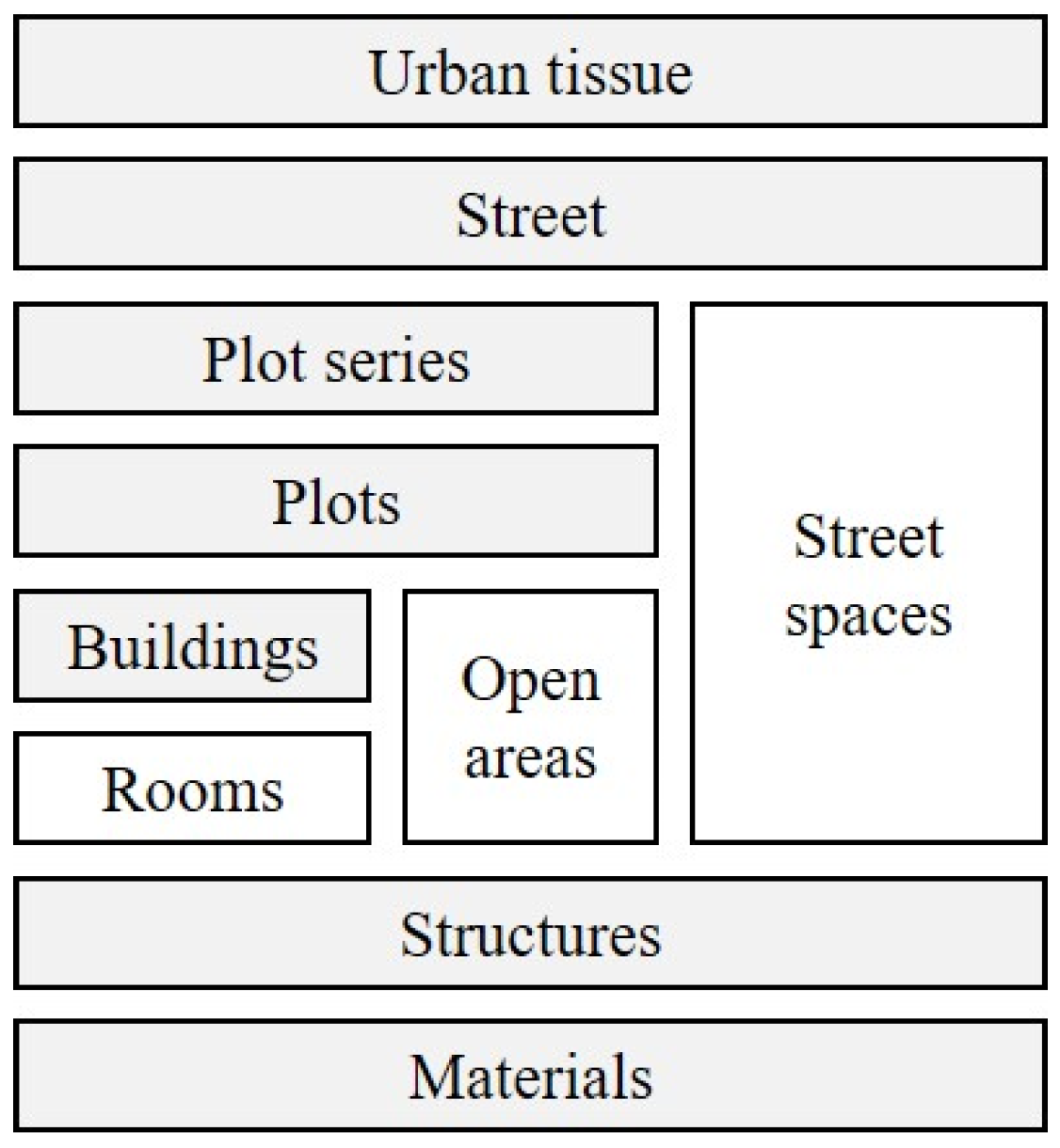


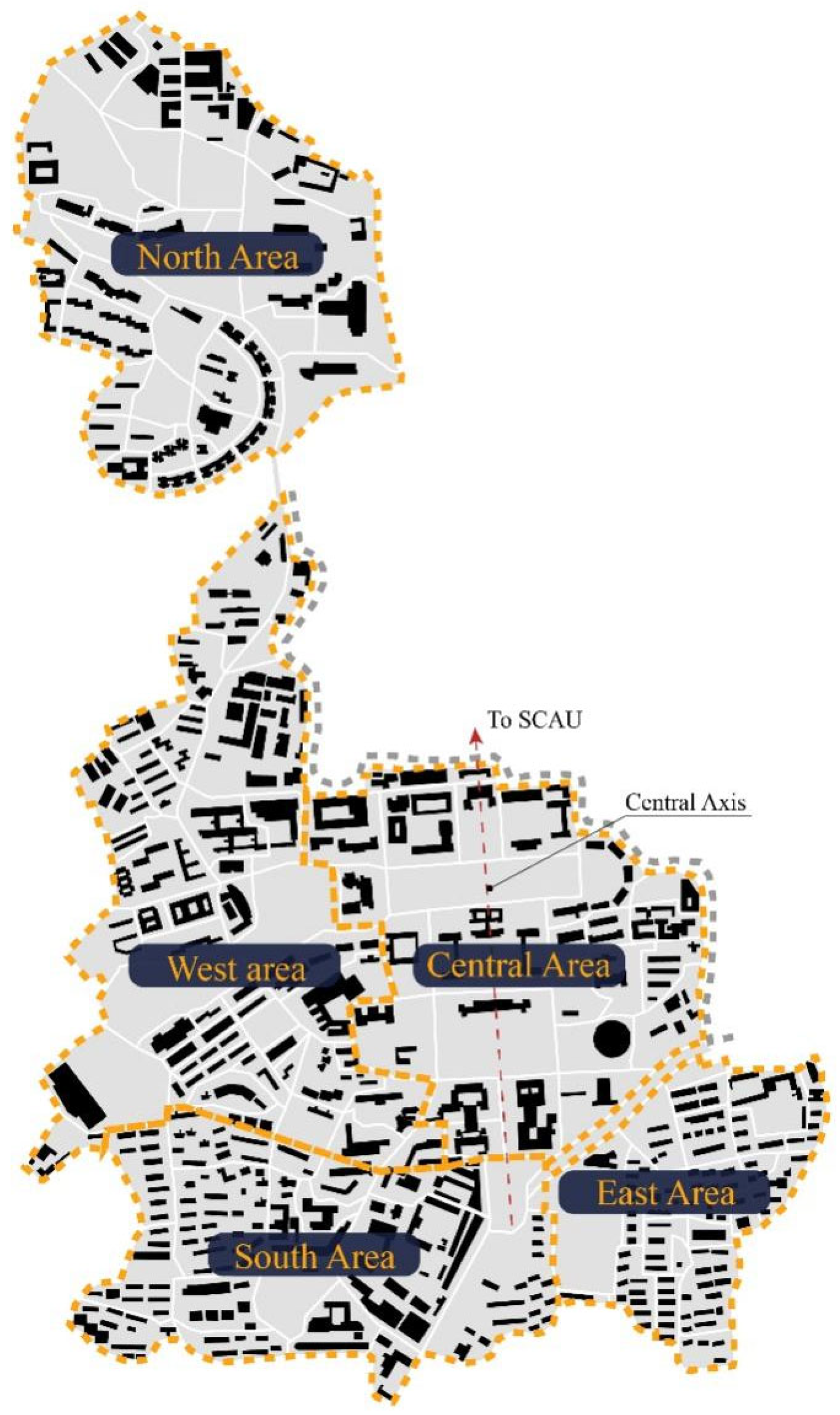


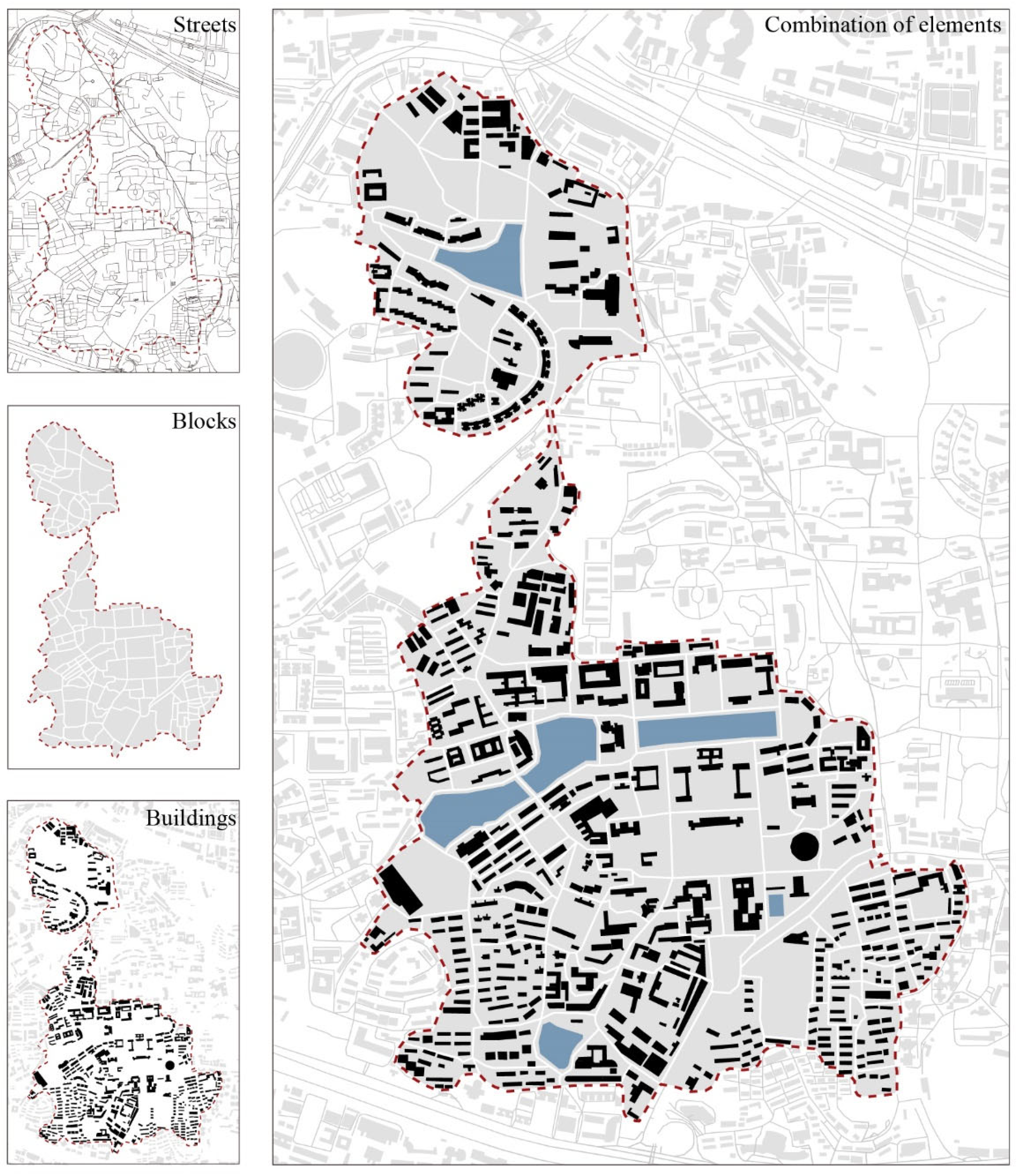
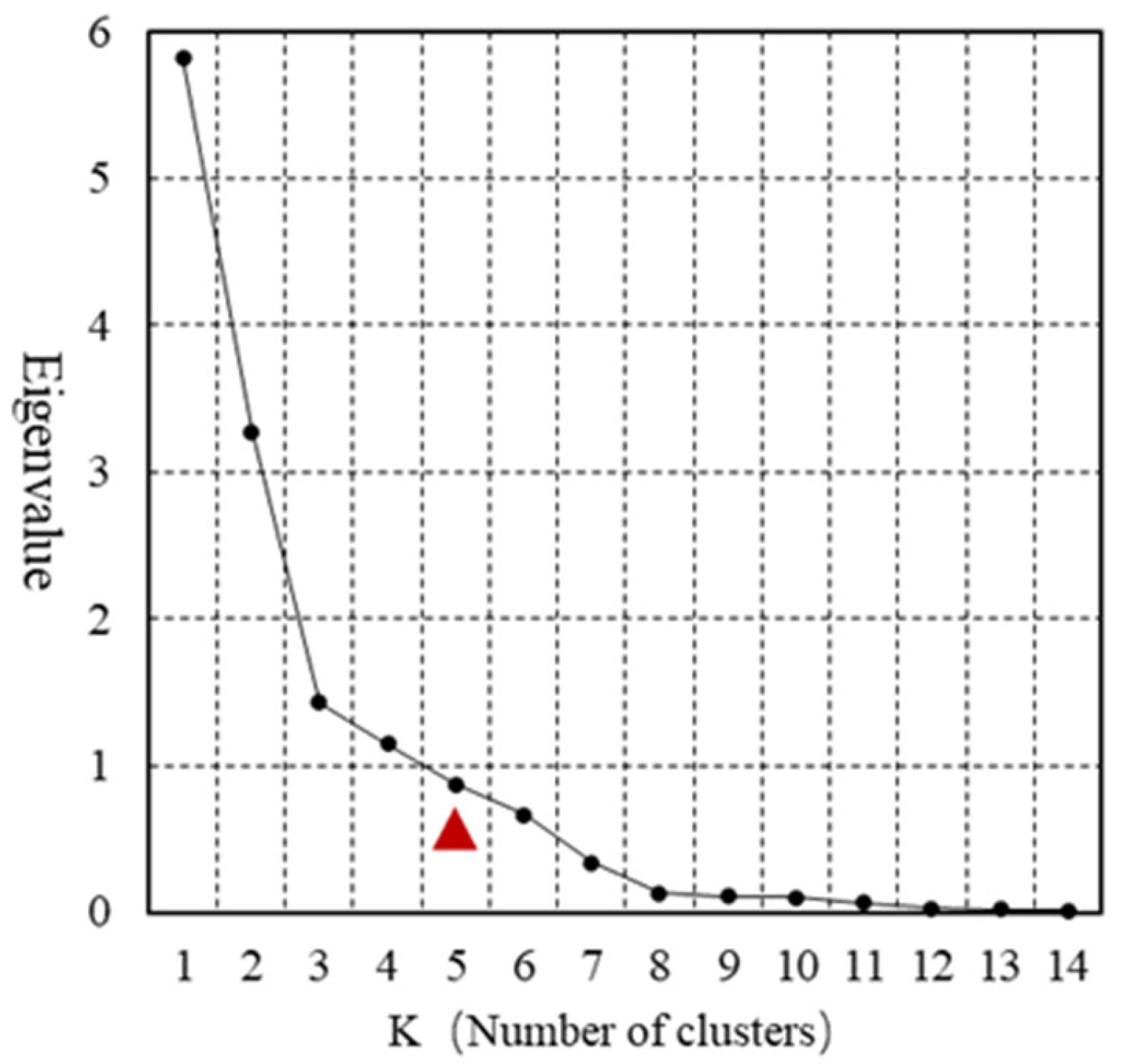
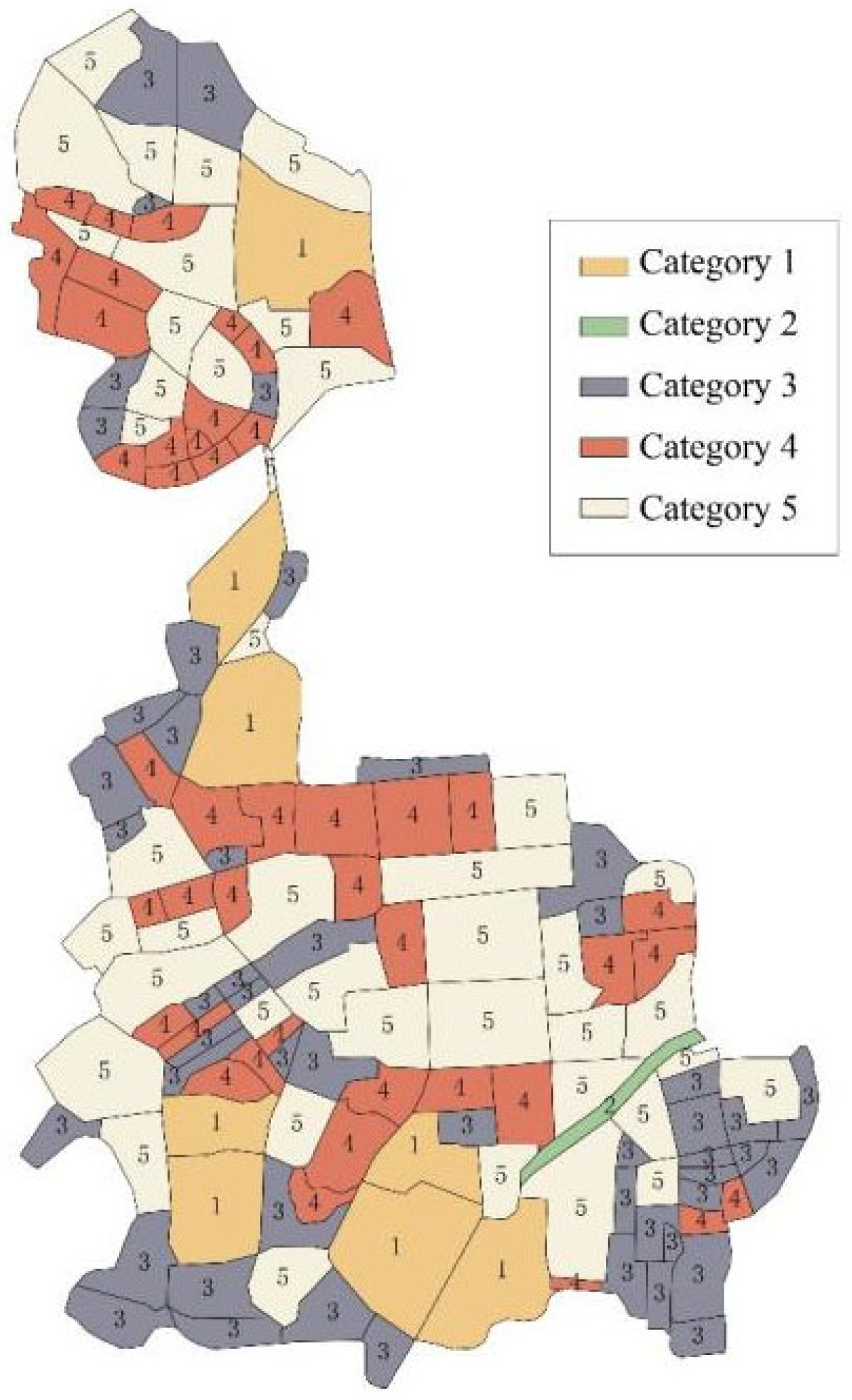

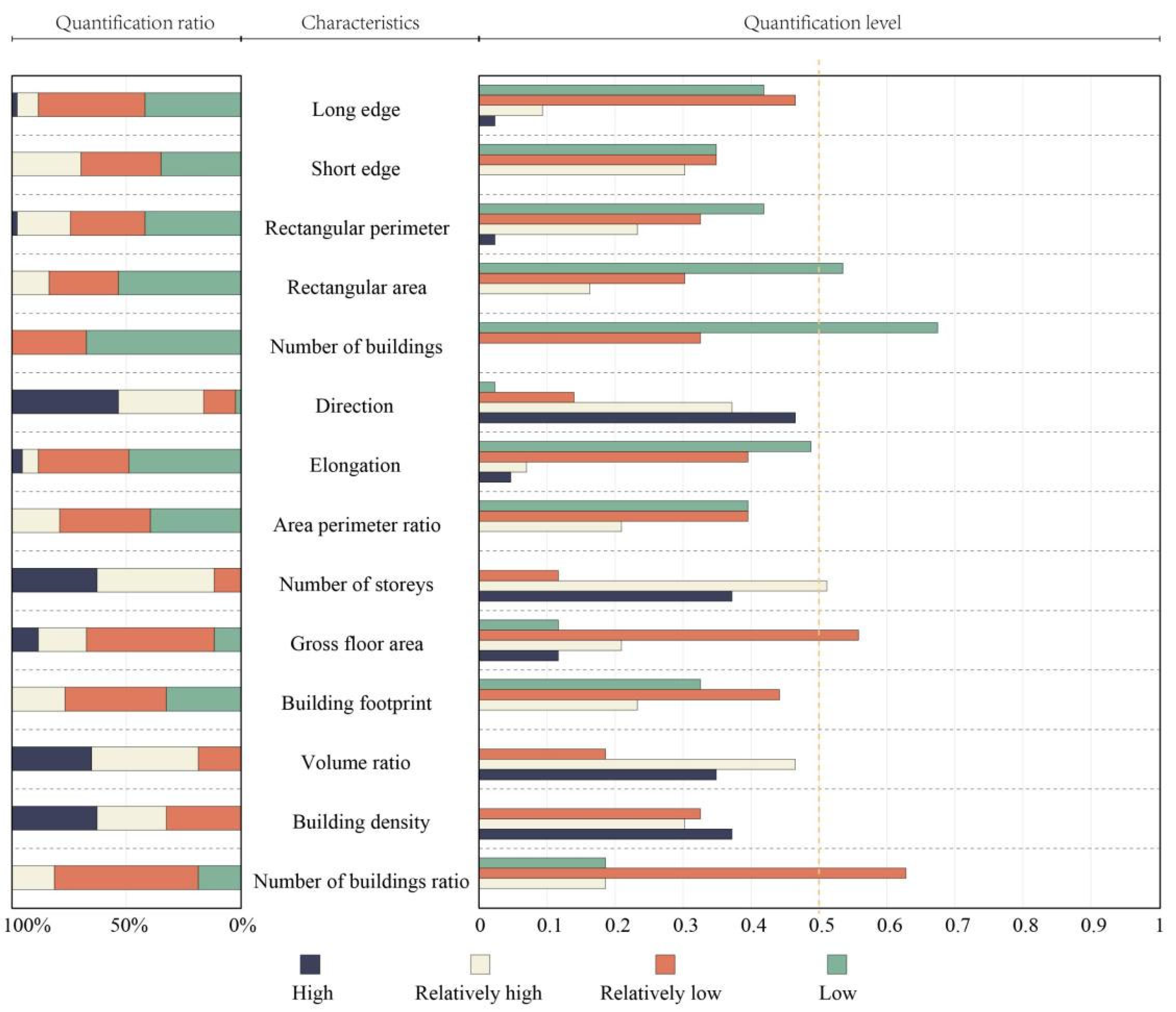

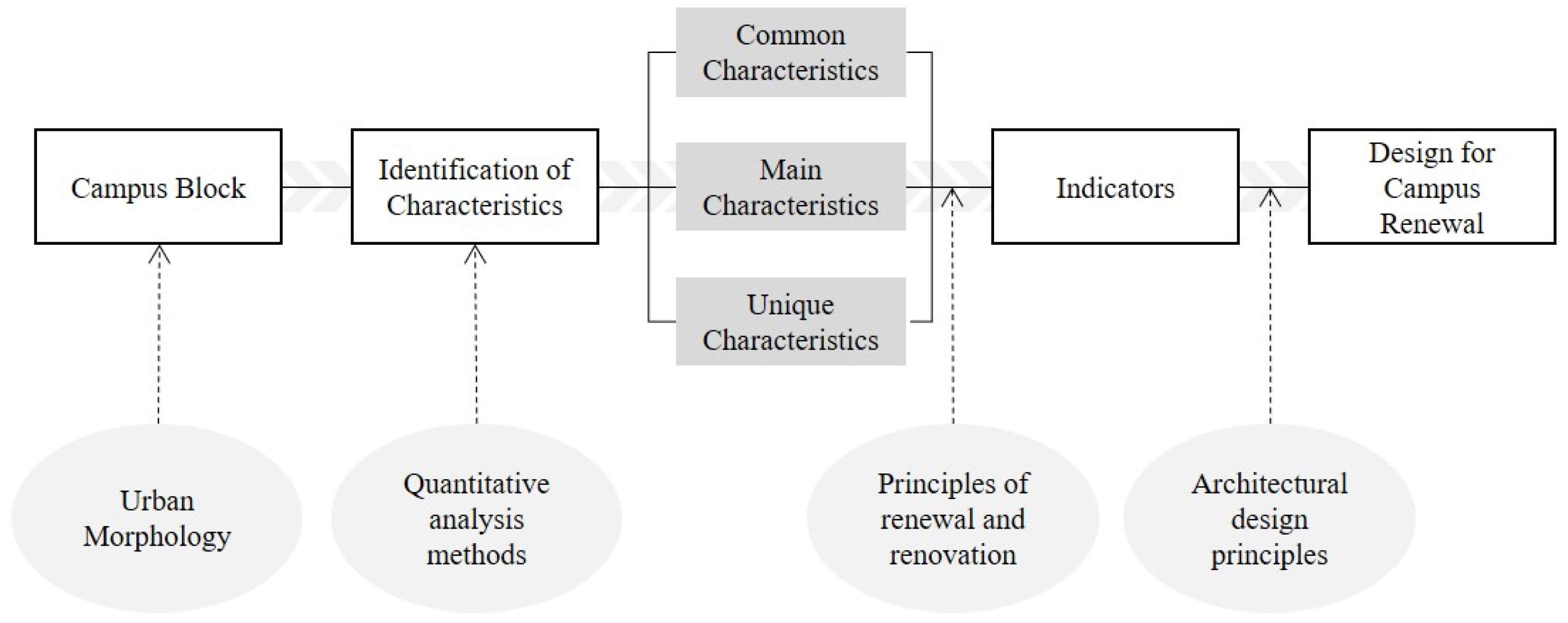
| Morphological Elements | Number | Morphological Element Characteristics | Unit |
|---|---|---|---|
| Campus block element | 1 | Long edge | m |
| 2 | Short edge | m | |
| 3 | Rectangular perimeter | m | |
| 4 | Rectangular area | m2 | |
| 5 | Number of buildings | Quantity | |
| 6 | Direction | ° | |
| 7 | Elongation | m/m | |
| 8 | Area perimeter ratio | m2/m | |
| 9 | Number of stories | Quantity | |
| 10 | Gross floor area | m2 | |
| 11 | Building footprint | m2 | |
| 12 | Volume ratio | m2/m2 | |
| 13 | Floor area ratio | m2/m2 | |
| 14 | Number of buildings ratio | Quantity/m2 |
| KMO and Bartlett’s Test | ||
|---|---|---|
| Kaiser–Meyer–Olkin measure of sampling adequacy | 0.715 | |
| Bartlett’s test of sphericity | Approximate chi-square | 2654.882 |
| df | 91 | |
| Sig. | 0.000 | |
| Parameters | Components | |||
|---|---|---|---|---|
| Factor 1 | Factor 2 | Factor 3 | Factor 4 | |
| Z-score (long edge) | 0.800 | −0.262 | 0.459 | −0.021 |
| Z-score (short edge) | 0.881 | −0.200 | −0.336 | −0.061 |
| Z-score (rectangular perimeter) | 0.925 | −0.236 | 0.171 | −0.048 |
| Z-score (rectangular area) | 0.957 | −0.170 | −0.070 | −0.018 |
| Z-score (number of buildings) | 0.621 | 0.275 | −0.079 | 0.580 |
| Z-score (direction) | −0.066 | 0.267 | −0.077 | −0.632 |
| Z-score (elongation) | −0.172 | −0.040 | 0.963 | 0.045 |
| Z-score (area perimeter ratio) | 0.925 | −0.148 | −0.244 | −0.065 |
| Z-score (number of stories) | −0.083 | 0.773 | −0.142 | −0.051 |
| Z-score (gross floor area) | 0.739 | 0.561 | −0.099 | 0.076 |
| Z-score (building footprint) | 0.804 | 0.386 | −0.097 | 0.174 |
| Z-score (volume ratio) | −0.139 | 0.935 | 0.031 | −0.039 |
| Z-score (floor area ratio) | −0.035 | 0.832 | 0.045 | 0.153 |
| Z-score (number of buildings ratio) | −0.243 | 0.380 | −0.015 | 0.758 |
| Component | Initial Eigenvalues | Rotation Sums of Squared Loadings | ||||
|---|---|---|---|---|---|---|
| Total | % of Variance | Cumulative % | Total | % of Variance | Cumulative % | |
| 1 | 5.825 | 41.609 | 41.609 | 5.825 | 41.609 | 41.609 |
| 2 | 3.275 | 23.393 | 65.002 | 3.275 | 23.393 | 65.002 |
| 3 | 1.425 | 10.181 | 75.184 | 1.425 | 10.181 | 75.184 |
| 4 | 1.143 | 8.163 | 83.346 | 1.143 | 8.163 | 83.346 |
| 5 | 0.872 | 6.229 | 89.575 | |||
| 6 | 0.664 | 4.741 | 94.315 | |||
| 7 | 0.336 | 2.397 | 96.712 | |||
| 8 | 0.128 | 0.913 | 97.625 | |||
| 9 | 0.108 | 0.772 | 98.398 | |||
| 10 | 0.097 | 0.696 | 99.093 | |||
| 11 | 0.063 | 0.449 | 99.543 | |||
| 12 | 0.030 | 0.213 | 99.756 | |||
| 13 | 0.022 | 0.156 | 99.912 | |||
| 14 | 0.012 | 0.088 | 100.000 | |||
| No. | Morphological Element Characteristics | Example 1 | Example 2 | Example 3 | Example 4 | Example 5 |
|---|---|---|---|---|---|---|
| Block No. 101 | Block No. 24 | Block No. 3 | Block No. 46 | Block No. 26 | ||
| 1 | Long edge | 353 | 447 | 119 | 126 | 201 |
| 2 | Short edge | 195 | 44 | 58 | 70 | 138 |
| 3 | Rectangular perimeter | 1017 | 1021 | 360 | 371 | 631 |
| 4 | Rectangular area | 50,645 | 13,746 | 6901 | 8216 | 19,448 |
| 5 | Number of buildings | 18 | 0 | 4 | 2 | 6 |
| 6 | Direction | 29 | 51 | 75 | 174 | 180 |
| 7 | Elongation | 2 | 10 | 2 | 2 | 1 |
| 8 | Area perimeter ration | 50 | 13 | 19 | 22 | 31 |
| 9 | Number of stories | 14 | 0 | 8 | 9 | 6 |
| 10 | Gross floor area | 74,298 | 0 | 17,060 | 24,953 | 12,412 |
| 11 | Building footprint | 5184 | 0 | 2133 | 2807 | 1916 |
| 12 | Volume ratio | 1.47 | 0 | 2.47 | 3.04 | 0.64 |
| 13 | Floor area ratio | 0.10 | 0 | 0.31 | 0.34 | 0.10 |
| 14 | Number of buildings ratio | 3.55 | 0 | 5.79 | 2.43 | 3.09 |
| Characteristic Level | Standard Values | Range of Control | |
|---|---|---|---|
| Unique characteristics | Volume ratio | 3.36 | 2.69–4.04 |
| Floor area ratio | 0.24 | 0.19–0.43 | |
| Main characteristics | Rectangular area | 10,398.84 | 7279.19–13,518.49 |
| Number of buildings | 1.99 | 1.39–3.38 | |
| Number of stories | 14.20 | 9.94–18.47 | |
| Gross floor area | 31,853.46 | 22,297.42–54,150.88 | |
| Number of buildings ratio | 2.23 | 1.56–2.91 | |
Publisher’s Note: MDPI stays neutral with regard to jurisdictional claims in published maps and institutional affiliations. |
© 2022 by the authors. Licensee MDPI, Basel, Switzerland. This article is an open access article distributed under the terms and conditions of the Creative Commons Attribution (CC BY) license (https://creativecommons.org/licenses/by/4.0/).
Share and Cite
Guo, W.; Ding, Y.; Yang, G.; Liu, X. Research on the Indicators of Sustainable Campus Renewal and Reconstruction in Pursuit of Continuous Historical and Regional Context. Buildings 2022, 12, 1508. https://doi.org/10.3390/buildings12101508
Guo W, Ding Y, Yang G, Liu X. Research on the Indicators of Sustainable Campus Renewal and Reconstruction in Pursuit of Continuous Historical and Regional Context. Buildings. 2022; 12(10):1508. https://doi.org/10.3390/buildings12101508
Chicago/Turabian StyleGuo, Weihong, Yaqian Ding, Guang Yang, and Xiao Liu. 2022. "Research on the Indicators of Sustainable Campus Renewal and Reconstruction in Pursuit of Continuous Historical and Regional Context" Buildings 12, no. 10: 1508. https://doi.org/10.3390/buildings12101508
APA StyleGuo, W., Ding, Y., Yang, G., & Liu, X. (2022). Research on the Indicators of Sustainable Campus Renewal and Reconstruction in Pursuit of Continuous Historical and Regional Context. Buildings, 12(10), 1508. https://doi.org/10.3390/buildings12101508








